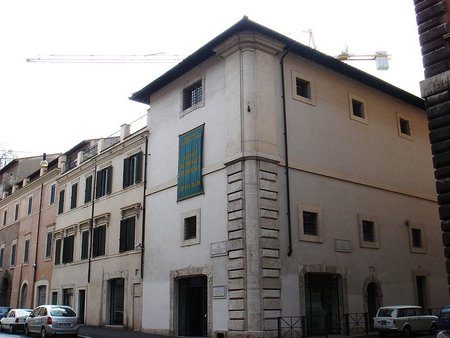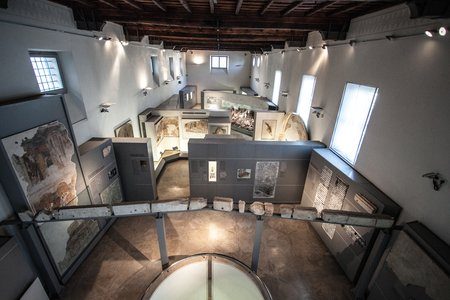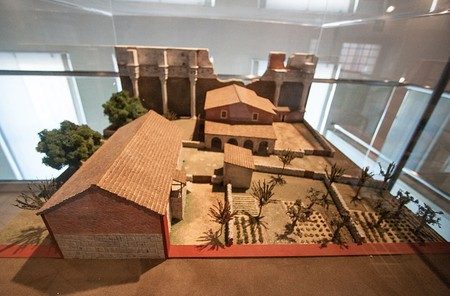The Crypta Balbi actually occupies an entire city block and this includes the ruins of a royal building, an excavation site and a museum that details how Rome has changed ever since the age of the emperors. Originally it was a large courtyard annexed to a theatre and now it’s home to a 3 floored museum that has artefacts recovered from the excavations, ruin pieces, ceramic objects and tools.
It’s important to know a little about the constructs that stood here. The main occupants were the large theatre with its covered porch, derelict walls, bathroom, erstwhile productive workshops and landfills apart from the vegetable garden of nuns of Santa Caterina dei Funari. The north side of the Balbo complex portico is a road system that has now become the via delle Botteghe Oscure. Lines of the first merchant houses queue up here along with the 9th century saint Maria Domine Rose church. Later in the renaissance era the Santa Caterina dei Funari church was constructed here.

Romans will tell you that the Crypta Balbi is the least glamorous and often the most overlooked member of the National Museums of Rome family. However it stands on the actual ruins of the Theatre of Balbo’s (13th century) and you have this pretty cool option of going down and seeing the ruins hidden under the modern museum. Also the crypt Balbi gives the clearest insight possible into what historical centre of Rome looked like.
The ticket office at the entrance will give you a printed map in English along with a free informative pamphlet.
History
In 1981 there was a major excavation project on the abandoned site of Campus Martius between the churches of Santa Caterina dei Funari and San Stanislao dei Polacchi. The excavation was spearheaded by Daniel Macorda and his team is credited with the discovery of the colonnaded quadriporticus of Lucius Cornelius Balbus.
The original building i.e. the Balbi Crypt and theatre complex is estimated to have been built between 19th to 13th BC under the instructions of Lucius Cornelius Balbus. The building was a 4 floor block theatre with a crypt and ancient Romans used to eat, drink and gossip in there between the performances breaks. Of course like many other Roman buildings, it collapsed due to being unused and Romans again began building on top of the ruins and very soon the Balbi Crypt was forgotten till the excavation re-discovered it. The building was restored but it took 20 years for it to become a part of the National Museum of Rome.
The museum was inaugurated in 2001 and hosts the archaeological findings from the excavation. There are exhibits from the earlier Kircherian museum, Gorga and Betti collections and a few exhibits sourced from Roman Forum and Palazzo Venezia museum.
The name Crypta Balbi come from the huge porticoes courtyard that was annexed to the Theatrum Balbi and now much of the ancient buildings are accessible to visitors. The pavement and walls of the portico are from the times of the emperors and much of the medieval constructs of the now crumbled Chiesa di Santa Maria Domine Rose are also a part of the museum complex.
Museum Sections
Basement
Contains sensitive archaeological remains of the theatre of Balbus and is only accessible via a guided tour. Visitors can walk along the damp and dark passageways while enjoying the atmospheric exhibits. This in a mostly unlabelled portion so taking along a guide anyway makes sense.
Ground Floor (Archaeology & History of Urban Landscape)
The first section has chronologically detailed exhibits from the excavation and they show the history of the area. Lovers of ancient Roman history will like the exhibits that show visitors stories of Conservatorio di Santa Caterina funari… this was a 16th century construct commissioned by Ignatius of Loyola and it used to house the daughters of Roman courtesans. Another fascinating series of exhibits is about the 8th century Santa Maria Domine Rose.
This is purely dedicated to a series of archaeological investigations that tells the history and archaeological significance of the Balbo Complex along with the nearby Porticus Minucia Frumentaria.

First Floor
Recent archaeological activities have unearthed a series of complex buildings that were built on the eastern periphery of Crypta Balbi after the fire of 80 AD. The houses, shops and buildings in this area underwent multiple transformations until they were finally abandoned in the 17th century AD. There are exhibits of craftsmen’s residences and homes of merchants in this section.
Second Floor (Rome from antiquity to middle ages)
This portion is dedicated to ‘Rome from antiquity’ to Middle Ages. It’s visit worthy for details on the transformation of Rome from the 5th to the 10th century AD.
Precious ornaments and beautiful ceramic pottery that were estimated to have been made between the 16th to 17th centuries are displayed here. It’s fascinating to see the styles of rings, hair clips, refined tools that were used in pre Latin times. Also fascinating is the numinastic collection that showcases coins (bronze, silver and gold) that date back to the Byzantine era. Interestingly some 370 of these coins were excavated from a submerged drain below the bathroom located in the exedra of Crypta Balbi.

The archaeological area of the exedra is accessible only to small groups. This section is not only comprised of excavated items from this area but also from other historical collections of Roman Museums including Capitoline museums, Forum and Palazzo Venezia. The fragment of the huge Forma Urbis Rome (huge marble map of Rome) that was created in 3rd century by Septimius Severus and the frescoes sourced from Santa Maria Via Latta are of special interest.
The northern perimeter wall of the crypta-balbi has well preserved ruins of ancient homes that might be interesting to observe. The best thing about Crypta Balbi is that it has all extensive notes and explanations. The experience is mostly like attending a graduate history seminar.
Location & Hours
The crypta Balbi lies in just off the Jewish ghetto/ largo di torre Argentina. It’s located at the junction of Via Delle Botteghe Oscure 31 and Via M Caetani ….just a few minutes of walk away westward from the Piazza Campidoglio on the Capitoline Hills.
It’s in the heart of the city so access is easy. There is a nearby Bus stop Via Torre Argentina and you can avail bus numbers 40, 46, 87, 116, 116T, 186, 492, 628 to reach it. Alternatively take Tram 8 to Venezia or Metro Line B to Colosseum and walk till the Crypta Balbi.
Address: Via delle Botteghe Oscure, 31. Phone: +39 06 399 67 701
The Crypta Balbi Museum is open daily from 9am to 7:45pm, except Mondays, new year and Christmas. The archaeological area of Exedra currently is accessible during weekends only to groups (max 20 tourists) if accompanied by a member of the museum staff at following hours:
10.45 am – 11.45 am, 12.45 am – 2.45 pm, 3.45 pm – 4.45 pm. Entry allowed from the last Sunday of October till 15 February.
For ticketing details, go through National Roman Museum.
Note:
The Crypta Balbi is the only Italian museum that organically rises from archaeological excavations that happened in a single block between via delle Botteghe Oscure, Via Caetani, Via dei Delfini and Via dei Polacchi. Rome has more than 2000 year of history and Crypta Balbi provides a unique view; how an entire block of Roma changed during those 2000 years. The exhibits here do not belong to kings, counts or Popes so they are quite commonplace household items which visitors may feel a kinship for. In short a visit to this well explained and smaller less touristy museum is an opportunity to have a quiet and extensive history and culture lesson on Rome.
 A travel addict. Still celebrating the day when he quit his high-profile corporate job to pursue his passion for travel writing.
A travel addict. Still celebrating the day when he quit his high-profile corporate job to pursue his passion for travel writing.